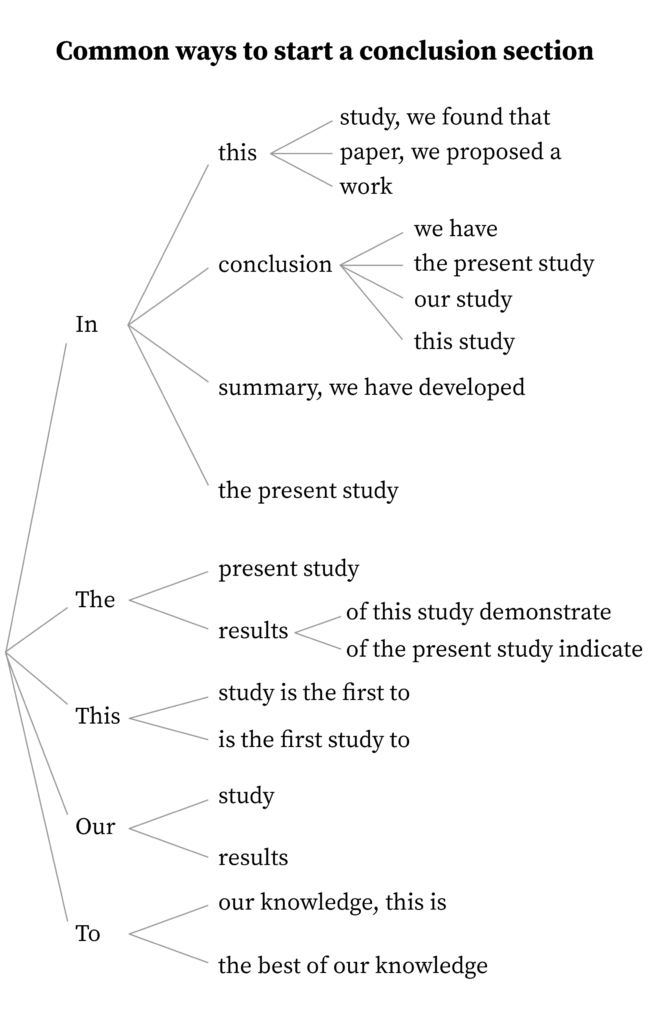The examples below are from 47,803 full-text PubMed research papers that I analyzed in order to explore common ways to start a Conclusion section.
The research papers included in this analysis were selected at random from those uploaded to PubMed Central between the years 2016 and 2021. Note that I used the BioC API to download the data (see the References section below).
Examples of how to start a Conclusion section
The Conclusion section should remind the reader of the most important finding and its implications. [Source: How to Write & Publish a Research Paper: Step-by-Step Guide]
It can start with a sentence that:
1. Restates the objective of the study
For example:
“The aim of this study was to develop novel type of nanobiomaterials for biomedical applications with advanced properties using only biocompatible components.”
Source: taken from the conclusion section of this PubMed article
2. Emphasizes the strength of the study
For example:
“To the best of our knowledge, this was the first study that analyzed children’s energy balance, in both a school setting and a summer camp, with the aim of assessing whether the dietary intake of children was adequate to cover their needs during both school and summer camp days.”
Source: taken from the conclusion section of this PubMed article
3. Summarizes the most important finding of the study
For example:
“The results of this study demonstrate that early application of combined echinocandins/TMP-SMX treatment for AIDS-PCP patients can improve patient prognosis, increase their survival rate, and decrease their mortality rate.”
Source: taken from the conclusion section of this PubMed article
Common words used to start a conclusion
Here’s a decision tree that shows the most popular words used at the start of a conclusion:

5.74% of studies start the Conclusion section with: “In conclusion”
In our sample of 47,803 research papers, 2,744 (5.74%) Conclusion sections started with the words: “In conclusion”.
Example 1:
“In conclusion, we have identified the radical species that promoted the stereoinversion of vinylic compounds during the preparation of potassium vinyltrifluoroborate salts.”
Source: taken from the conclusion section of this PubMed article
Example 2:
“In conclusion, liver cell injury might occur in the early stage of COVID-19.”
Source: taken from the conclusion section of this PubMed article
Example 3:
“In conclusion, the results of the present study indicate the potential use of themedicinal species for oral candidosis prevention or treatment and emphasize the action of the crude C. sativum essential oil, which demonstrates a strong activity against Candida spp. planktonic cells and C. albicans biofilm.”
Source: taken from the conclusion section of this PubMed article
0.07% of Conclusions end with a question
Only 34 out of 47,803 (0.07%) of the Conclusion sections in our sample ended with a question.
Example 1:
“Future experiments may seek the answers to a number of important questions: Are the effects of light quality on plants permanent? What portion of the blue spectrum is actually needed for the growth of grape plantlets in vitro? Do the physiological and transcriptional responses of grape plantlets grown in vivo and in vitro differ?“
Source: taken from the conclusion section of this PubMed article
Example 2:
“The above observations raise an intriguing question: how SAHase, the protein with two Rossmann-folds, had evolved during the development of life on Earth?“
Source: taken from the conclusion section of this PubMed article
Example 3:
“Researchers using these tools will be able to confirm and verify any hypothesis in HD and answer the question why and how do striatal neurons primarily die?“
Source: taken from the conclusion section of this PubMed article
References
- Comeau DC, Wei CH, Islamaj Doğan R, and Lu Z. PMC text mining subset in BioC: about 3 million full text articles and growing, Bioinformatics, btz070, 2019.